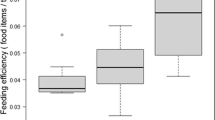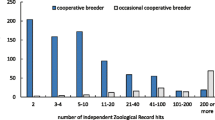Abstract
Although cooperative breeding is known from only about 9 % of bird species, it has received substantial attention because individuals foregoing their own reproduction to help others represent a long-standing evolutionary puzzle. We studied group formation, breeding system, spatial distribution and several life-history traits of white-breasted mesites (Mesitornis variegata). Based on field observations across 3 years, we found that white-breasted mesites live in year-round stable pairs, and that groups are formed by juvenile philopatry. As other family-living birds, M. variegata exhibit a slow pace-of-life, characterized by high annual adult survival, low productivity, long chick dependence and extended parental care. However, although reproduction is monogamous and juveniles showed interest in their parents’ nests, we found no evidence of cooperative breeding. We suggest that slow life-histories, extended parental care and year-round territoriality predispose juvenile mesites to delay dispersal. However, adult intolerance toward older juveniles may prevent them from adopting a cooperative lifestyle. Comparisons with other species of mesite indicate that monogamy and delayed juvenile dispersal are necessary, but not sufficient for the evolution of cooperative breeding in this family of birds, and that particular ecological and social conditions have facilitated the transition from pair-living to a type of group that may represent a stepping stone in the evolution of cooperative breeding in mesites and other birds.




Similar content being viewed by others
References
Arnold KE, Owens IPF (1998) Cooperative breeding in birds: a comparative test of the life history hypothesis. Proc R Soc Lond B 265:739–745
Baglione V, Marcos JM, Canestrari D, Griesser M, Andreotti G, Bardini C, Bogliani G (2005) Does year-round territoriality rather than habitat saturation explain delayed natal dispersal and cooperative breeding in the carrion crow? J Anim Ecol 74:842–851
Cahan S, Blumstein D, Sundström L, Liebig J, Griffin A (2002) Social trajectories and the evolution of social behavior. Oikos 96:206–216
Clutton-Brock T (2002) Breeding together: kin selection and mutualism in cooperative vertebrates. Science 296:69–72
Cockburn A (1998) Evolution of helping behaviour in cooperatively breeding birds. Annu Rev Ecol Syst 29:141–177
Cockburn A (2006) Prevalence of different modes of parental care in birds. Proc R Soc Lond B 273:1375–1383
Cornwallis CK, West SA, Davis KE, Griffin AS (2010) Promiscuity and the evolutionary transition to complex societies. Nature 466:969–972
Covas R, Griesser M (2007) Life history and the evolution of family living in birds. Proc R Soc Lond B 274:1349–1357
Davies N (2000) Multi-male breeding groups in birds: ecological causes and social conflicts. In: Kappeler P (ed) Primate males. Cambridge Univ. Press, Cambridge, pp 11–20
Ebbinge B, Van Biezen J, Van der Voet H (1991) Estimation of annual adult survival rates of Barnacle Geese Branta leucopsis using multiple resightings of marked individuals. Ardea 79:73–112
Ekman J, Sklepkovych B, Tegelstrom H (1994) Offspring retention in the Siberian jay (Perisoreus infaustus): the prolonged brood care hypothesis. Behav Ecol 5:245–253
Ekman J, Bylin A, Tegelstrom H (2000) Parental nepotism enhances survival of retained offspring in the Siberian jay. Behav Ecol 11:416–420
Emlen ST (1982) The evolution of helping: I. An ecological constraints model. Am Nat 119:29–39
Evans M, Hawkins AFA, Duckworth J (1996) Family Mesitornithidae (Mesites). In: del Hoyo J, Elliott A, Sargatal J (eds) Handbook of the birds of the world. Lynx Edicions, Barcelona, pp 34–43
Gamero A, Buser A, Kappeler P (2013) Characterization of 10 polymorphic microsatellite loci for white-breasted mesites (Mesitornis variegata). Conserv Genet Resour 5:553–554
Griffiths R, Double MC, Orr K, Dawson RJG (1998) A DNA test to sex most birds. Mol Ecol 7:1071–1075
Hackett SJ, Kimball RT, Reddy S, Bowie RCK, Braun EL et al (2008) A phylogenomic study of birds reveals their evolutionary history. Science 320:1763–1768
Hatchwell BJ (2009) The evolution of cooperative breeding in birds: kinship, dispersal and life history. Phil Trans R Soc B 364:3217–3227
Hatchwell BJ, Komdeur J (2000) Ecological constraints, life history traits and the evolution of cooperative breeding. Anim Behav 59:1079–1086
Hawkins AFA (1994) Conservation status and regional population estimates of the white-breasted mesite Mesitornis variegata, a rare Malagasy endemic. Bird Conserv Int 4:279–303
Hawkins AFA, Seddon N (2003) Mesitornithidae, Mesites. In: Goodman SM, Benstead JP (eds) The natural history of Madagascar. Univ. Chicago Press, Chicago, pp 1095–1098
Heinsohn RG (1991) Slow learning of foraging skills and extended parental care in cooperatively breeding white-winged choughs. Am Nat 137:864–881
Hughes WOH, Oldroyd BP, Beekman M, Ratnieks FLW (2008) Ancestral monogamy shows kin selection is key to the evolution of eusociality. Science 320:1213–1216
Jetz W, Rubenstein DR (2011) Environmental uncertainty and the global biogeography of cooperative breeding in birds. Curr Biol 21:72–78
Jones OR, Wang J (2010) COLONY: a program for parentage and sibship inference from multilocus genotype data. Mol Ecol Resour 10:551–555
Kappeler P, Fichtel C (2012) A 15-year perspective on the social organization and life history of sifaka in Kirindy Forest. In: Kappeler P, Watts D (eds) Long-term field studies of primates. Springer, Berlin, pp 101–121
Kappeler PM, Barrett L, Blumstein DT, Clutton-Brock TH (2013) Constraints and flexibility in mammalian social behaviour: introduction and synthesis. Phil Trans R Soc B 368
Kokko H, Ekman J (2002) Delayed dispersal as a route to breeding: territorial inheritance, safe havens, and ecological constraints. Am Nat 160:468–484
Komdeur J (1992) Importance of habitat saturation and territory quality for evolution of cooperative breeding in the Seychelles warbler. Nature 358:493–495
Komdeur J, Ekman J (2010) Adaptations and constraints in the evolution of delayed dispersal: implications for cooperation. In: Székely T, Moore AJ, Komdeur J (eds) Social behaviour: genes, ecology and evolution. Cambridge Univ. Press, Cambridge, pp 306–327
Kranstauber B, Smolla M (2013) Move: visualizing and analyzing animal track data. R package version 1.1.424. http://CRAN.R-project.org/package=move
Krause J, Ruxton GD (2002) Living in groups. Oxford Univ, Press, New York
Leggett HC, El Mouden C, Wild G, West S (2012) Promiscuity and the evolution of cooperative breeding. Proc R Soc Lond B 279:1405–1411
Ligon JD, Burt DB (2004) Evolutionary origins. In: Koenig WD, Dickinson JL (eds) Ecology and evolution of cooperative breeding in birds. Cambridge Univ. Press, Cambridge, pp 5–34
Livezey BC, Zusi RL (2007) Higher-order phylogeny of modern birds (Theropoda, Aves: Neornithes) based on comparative anatomy: II. Analysis and discussion. Zool J Linn Soc Lond 149:1–95
Lukas D, Clutton-Brock T (2012) Cooperative breeding and monogamy in mammalian societies. Proc R Soc Lond B 279:2151–2156
Mumme RL (1992) Do helpers increase reproductive success? Behav Ecol Sociobiol 31:319–328
Pen I, Weissing FJ (2000) Towards a unified theory of cooperative breeding: the role of ecology and life history re-examined. Proc R Soc Lond B 267:2411–2418
Pienaar J, Ilany A, Geffen E, Yom-Tov Y (2013) Macroevolution of life-history traits in passerine birds: adaptation and phylogenetic inertia. Ecol Lett 16:571–576
Pyritz LW, Fichtel C, Huchard E, Kappeler PM (2013) Determinants and outcomes of decision-making, group coordination and social interactions during a foraging experiment in a wild primate. PLoS ONE 8:e53144
Queller DC, Goodnight KF (1989) Estimating relatedness using genetic markers. Evolution 43:258–275
Ramanitra N, Ravelson B, Randrianaina L (2006) Prospection et etude de l’espece Mesitornis variegata a Betampona et a Morondava. Unpubl. report. Conservation International
Ricklefs RE (1975) The evolution of co-operative breeding in birds. Ibis 117:531–534
Ricklefs RE (1979) Adaptation, constrain, and compromise in avian postnatal development. Biol Rev 54:269–290
Rollins LA, Browning LE, Holleley CE, Savage JL, Russell AF, Griffith SC (2012) Building genetic networks using relatedness information: a novel approach for the estimation of dispersal and characterization of group structure in social animals. Mol Ecol 21:1727–1740
Rubenstein DR, Lovette IJ (2007) Temporal environmental variability drives the evolution of cooperative breeding in birds. Curr Biol 17:1414–1419
Russell EM, Yom-Tov Y, Geffen E (2004) Extended parental care and delayed dispersal: northern, tropical, and southern passerines compared. Behav Ecol 15:831–838
Schaefer H-C, Eshiamwata GW, Munyekenye FB, Böhning-Gaese K (2004) Life-history of two African Sylvia warblers: low annual fecundity and long post-fledging care. Ibis 146:427–437
Seddon N, Tobias JA, Butchart SHM (2003) Group living, breeding behaviour and territoriality in the Subdesert Mesite (Monias benschi). Ibis 145:277–294
Seddon N, Amos W, Adcock G, Johnson K, Kraaijeveld K, Kraaijeveld-Smit FJL, Lee W, Senapathi GD, Mulder RA, Tobias JA (2005) Mating system, philpatry and patterns of kinship in the cooperatively breeding subdesert mesite Monias benschi. Mol Ecol 14:3573–3583
Sibley CG, Monroe BL (1990) Distribution and taxonomy of the birds of the world. Yale Univ. Press, New Haven
Stacey PB, Ligon JD (1991) The benefits-of-philopatry hypothesis for the evolution of cooperative breeding: variation in territory quality and group size effects. Am Nat 137:831–846
Stark JM, Ricklefs RE (1998) Avian growth and development. Oxford Univ. Press, New York
Tarwater CE, Brawn JD (2010a) Family living in a neotropical bird: variation in timing of dispersal and higher survival for delayed dispersers. Anim Behav 80:535–542
Tarwater CE, Brawn JD (2010b) The post-fledging period in a tropical bird: patterns of parental care and survival. J Avian Biol 41:479–487
Wang J (2011) coancestry: a program for simulating, estimating and analysing relatedness and inbreeding coefficients. Mol Ecol Resour 11:141–145
Woolfenden GE, Fitzpatrick JW (1978) The inheritance of territory in group-breeding birds. BioScience 28:104–108
Acknowledgments
We are grateful to T. Andrianjanahary, P. Lehikoinen, A. Nickel, J. Ramírez, A. Szabadvari, M. Razafindrasamba, J.P. Tolojanahary, M. Markolf, C. Oberdieck and S. Schliehe-Diecks for their help in the field and in the lab. This research was founded by Volkswagen Stiftung (I/84849) research project, Deutsches Primatenzentrum and the University of Göttingen. We thank the CNFEREF in Morondava, the Ministére d’Eaux et Forêt of Madagascar and the Département Biologie Animale of the University of Antananarivo for the authorization and support for the field work in Kirindy. We thank D. Rubenstein and two anonymous reviewers for helpful comments on a previous version of the manuscript.
Ethical statement
All procedures were approved by the Ministére d’Eaux et Forêt of Madagascar (210/09, 184/10, 342/10, 237/11, 056/12).
Conflict of interest
None.
Author information
Authors and Affiliations
Corresponding author
Additional information
Communicated by D. Rubenstein
Rights and permissions
About this article
Cite this article
Gamero, A., Székely, T. & Kappeler, P.M. Delayed juvenile dispersal and monogamy, but no cooperative breeding in white-breasted mesites (Mesitornis variegata). Behav Ecol Sociobiol 68, 73–83 (2014). https://doi.org/10.1007/s00265-013-1624-4
Received:
Revised:
Accepted:
Published:
Issue Date:
DOI: https://doi.org/10.1007/s00265-013-1624-4




